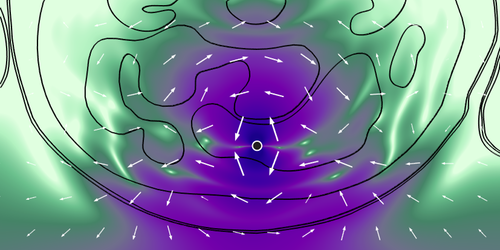Better Signals from Electronic Body Implants
A medical monitoring device can be implanted in the body to perform functions such as recording brain activity or analyzing blood. The device periodically transmits data wirelessly to a receiver outside the body, but the receiver needs to be within about a meter of the device because of the poor radiation efficiency of biological tissues. Now Denys Nikolayev from the University of Rennes 1, France, and colleagues predict that these transmissions could be made 10 times more efficient by choosing the right frequency. This efficiency increase could enable the transmission distance of these devices to be tripled.
The team modeled the propagation of electromagnetic waves through tissues to find the optimal operating conditions for an implanted device. They considered four geometrical arrangements. The simplest was a uniform slab of muscle with the transmitter embedded some distance below the surface, and the most complicated was a waist-level slice through the human body, complete with fat, stomach, and kidney tissues.
In all cases, the team found that the radiation efficiency of the transmitter improved as they increased the operating frequency up to a few gigahertz, above which the efficiency plummeted. (The exact optimal operating frequency depended on both the implantation depth and the thickness of fat and skin layers.) They also observed that most of the signal’s total energy (80%–99%) was lost at the interface between the body and the air, where the waves reflect back into the body. Attenuation of the signal as it traveled from the implant through the tissues was a much smaller effect.
This research is published in Physical Review Applied.
–Katherine Wright
Katherine Wright is a Contributing Editor for Physics.





